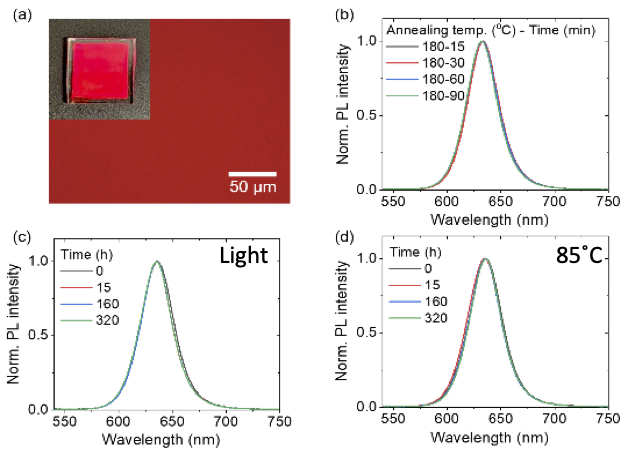How colour stable red perovskites advance colour conversion
A Helio Blog by Simon Jones (CEO)
The world knows that green perovskites are an exciting new photoluminescent material but less is understood about the potential for perovskites as red emitters. In this blog article, we update you on Helio's latest results with red perovskites and assess their advantages for colour conversion.
The increasing adoption of colour conversion as a way to increase the performance of displays is driving demand for greatly improved green and red photoluminescent materials. One example application is the concept of a "yellow" backlight film where green and red emitting materials are mixed in the same layer.
Perovskites are recognised as a material class with outstanding conversion efficiency, narrow emission spectra and simple fabrication. However, making a colour stable red perovskite is a challenge. This is because it is necessary to mix halides (iodide and bromide) to tune the colour, but under stress the halides tend to segregate causing the emission spectrum to change.
At SID Display Week 2021, Bernard Wenger (CTO) presented Helio’s latest results on red perovskite colour stability. He showed how we are now able to stress Helio’s red perovskite materials at 85˚C and under bright light for over 300 hours with no change in emission spectrum or photoluminescence. Helio is also demonstrating rapidly increasing photoluminescent efficiencies in our red films which are now approaching those of green.

Red perovskites offer important advantages in colour conversion. Firstly, like green perovskites, they show uniquely high optical density achieving light absorption in excess of 99.9% in films of less than 10 microns. This is critical for in-pixel applications and is extremely challenging for any other colour conversion technology. Secondly, their narrow and highly tunable emission spectra enable industry leading colour performance (>92% REC2020 is achievable by combining Helio’s green and red materials with a standard blue LED). Also, perovskites have a much faster (nanosecond) response time than phosphor-based approaches which is becoming important with the emergence of PWM miniLED backlights.
This significant progress on the colour stability of red perovskites has opened the door to industrial solutions that bring the advantages of perovskites to both red and green emitters. Having both technologies will enable Helio to offer fully compatible kits of red and green perovskite materials. Whether applied to backlight films or at the pixel level, this comprehensive solution for colour conversion will be an important building block for next generation displays.